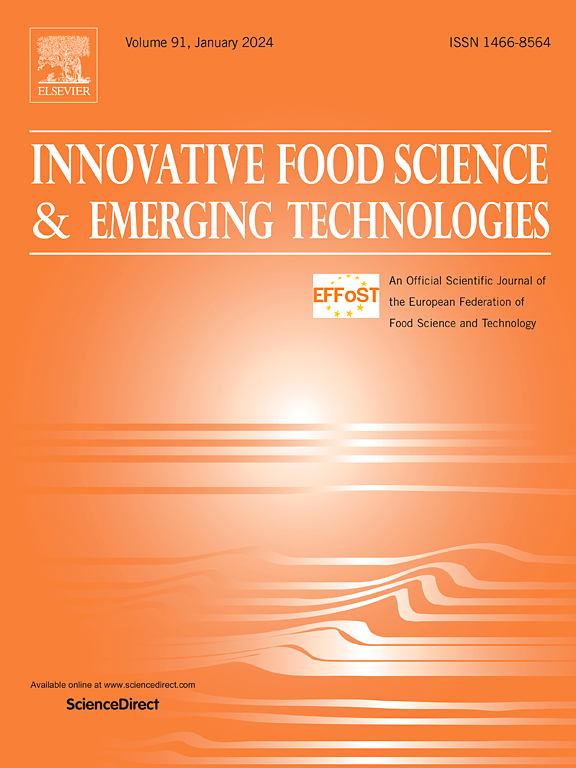在动态高压微流化处理过程中,增加压力和通道数可以调节紫苏种子蛋白的结构、技术功能和流变特性
IF 6.3
1区 农林科学
Q1 FOOD SCIENCE & TECHNOLOGY
Innovative Food Science & Emerging Technologies
Pub Date : 2025-04-22
DOI:10.1016/j.ifset.2025.104029
引用次数: 0
摘要
动态高压微流化(DHPM)等物理改性方法为提高植物蛋白在食品中的功能提供了一种新的手段。本研究系统探讨了压力(100、150和200 MPa)和孔道(3和6孔道)对紫苏分离蛋白(PPI)的结构、技术功能和流变性能的影响。扫描电镜(SEM)图像显示,在DHPM处理过程中,高剪切力改变了蛋白质的微观结构,使厚的蛋白质块变成更小、更薄的薄片。DHPM有效地分离了大的不溶性聚集体(>;1 μm)转化为可溶的,在较高的通道次(6次)观察到重新聚集。因此,DHPM显著提高PPI的溶解度,从48.45%提高到83.23%。DHPM(根据具体情况)诱导二级结构的改变和部分展开蛋白质结构,导致表面疏水性、巯基含量、荧光强度和紫外线吸收的变化。因此,它提高了储油能力、发泡和乳化性能、抗氧化活性和热稳定性。此外,DHPM处理降低了表观粘度,并表现出蛋白质分散体的剪切变薄行为。值得注意的是,100 MPa-3通道和200 MPa-3 &时的DHPM;6次转化后的蛋白分散体呈弱凝胶状,即储存模量(G′)>;损失模量(G”)到类液(G”>;G)字符。这些发现强调了利用压力和通道来定制植物蛋白用于各种食品应用的功能的潜力。本文章由计算机程序翻译,如有差异,请以英文原文为准。
Increasing pressure and number of passes during dynamic high-pressure microfluidization treatment modulates the structural, techno-functional, and rheological properties of perilla seed protein
Physical modification methods, like dynamic high-pressure microfluidization (DHPM), offer a novel means to enhance the functionality of plant proteins for food applications. This study systematically explored the impact of both pressure (100, 150, and 200 MPa) and passes (3 and 6 passes) on the structural, techno-functional, and rheological properties of perilla protein isolate (PPI) as a representative model protein. Scanning electron microscope (SEM) images revealed that the high shearing forces during DHPM treatment altered the protein microstructure, transforming thick protein blocks into smaller, thinner flakes. DHPM effectively dissociated large insoluble aggregates (> 1 μm) into soluble ones, with re-aggregation observed at higher passes (6 passes). Consequently, DHPM significantly increased PPI solubility from 48.45 % to 83.23 %. DHPM (on case-to-case basis) induced alterations in the secondary structure and partially unfolded the protein structure, led to changes in surface hydrophobicity, sulfhydryl content, fluorescent intensity, and UV absorbance. Therefore, it enhanced oil holding capacity, foaming and emulsification properties, antioxidant activities, and thermal stability. Additionally, DHPM treatment reduced the apparent viscosity and showed shear-thinning behavior of protein dispersions. Notably, DHPM at 100 MPa-3 passes and 200 MPa-3 & 6 passes transformed protein dispersions from a weak gel-like, i.e., storage modulus (G') > loss modulus (G") to a liquid-like (G" > G') character. These findings underscore the potential of utilizing both pressure and passes to tailor the functionality of plant proteins for various food applications.
求助全文
通过发布文献求助,成功后即可免费获取论文全文。
去求助
来源期刊
CiteScore
12.00
自引率
6.10%
发文量
259
审稿时长
25 days
期刊介绍:
Innovative Food Science and Emerging Technologies (IFSET) aims to provide the highest quality original contributions and few, mainly upon invitation, reviews on and highly innovative developments in food science and emerging food process technologies. The significance of the results either for the science community or for industrial R&D groups must be specified. Papers submitted must be of highest scientific quality and only those advancing current scientific knowledge and understanding or with technical relevance will be considered.

 求助内容:
求助内容: 应助结果提醒方式:
应助结果提醒方式:


